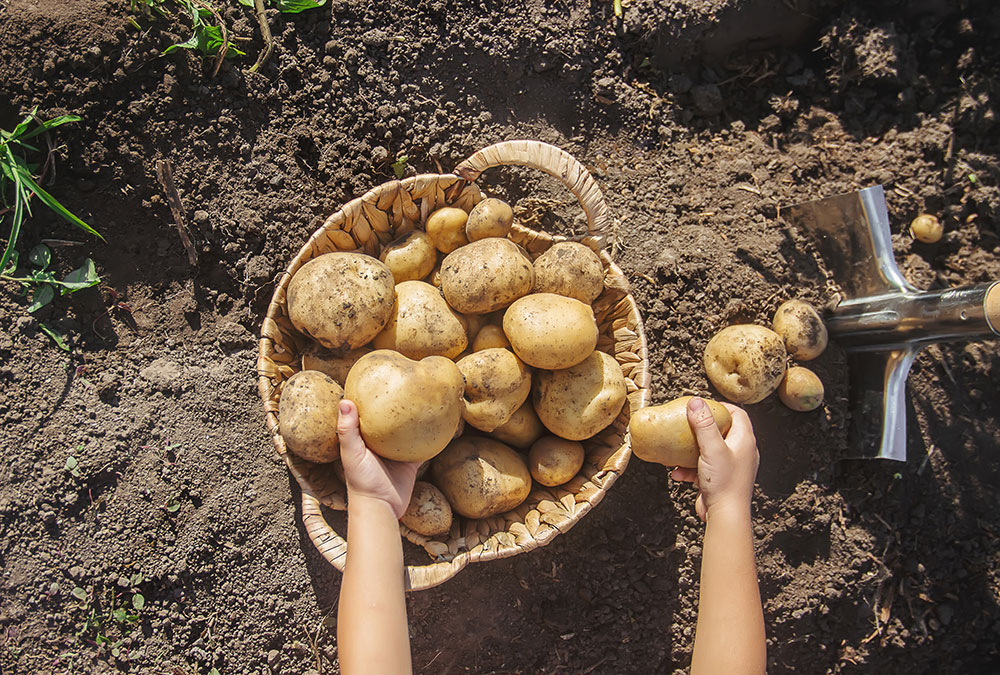Potatoes. They’re typically inexpensive and readily available, so why bother consider growing your own? We’ll explore that in this article, so read on!
Potato Varieties

Did you know that while the grocery store has fabulous potatoes in stock year round, selection has gone down over time. Potatoes aren’t created equal. Over centuries people have deloped new varieties of potatoes that have different qualities. Here are just a few variables that each potato variety has that you may want to consider:
- Culinary Purpose.
Some potatoes are better for baking, some are better for mashed, some are better for French fries, and some are great in a salad. - Disease Resistance.
Depending on your growing conditions and where you are located in the world, some potato varieties have a built-in resistance to common issues like scab and blight. You’ll want to determine if your growing conditions are susceptible to certain diseases and avoid potato varieties that don’t have build in resistance. - Days to Maturity
Potato varieties are often categorized as “Early, Mid, or Late Season” varieties which indicates how long it takes to grow full size tubers and then the potato ceases to produce. An early season potato grown in spring will reveal full-size potatoes in the Summer and you will have to harvest them. A late-season potato will take longer to mature, and often have better storage qualities built in. - Storage
As mentioned, some potato varieties have better abilities to store over the winter when stored in correct conditions. If you plan on growing potatoes to store over the winter, you will want to investigate whether the variety you are growing is meant for long-term storage. - Nutrition
Finally, some varieties have a different nutrition profile. For example, red or purple skin potatoes have higher antioxidants.
Additionally potatoes will have different flavour profiles – some can be flowery, nutty, or earthy. Potatoes can also have different levels of moisture, some being very moist, and others being dry.
By growing your own potatoes, you can be in charge of what varieties you want to grow for what you value most in a potato!
County Farm Centre selects potato varieties that are popular, easy to grow and appropriate for our climate and soil conditions. We’ve taken a lot of the hard work from selecting from hundreds of varieties. Here are our top 6 selections which you can find in our store at 38 Cold Storage Road, in Picton:
- Goldrush
With mid-season maturity, Gold Rush is considered an early russet. Flesh is dry and airy, perfect for frying or baking. Plants are medium to large with an upright growth habit. - Chieftain
Large, oblong red tubers with great flavor and storage potential. Deliciously boiled and as a new potato with firm, moist flesh. Higher yielding in heavy clay soils than other reds and offers field resistance to late blight. - Superior
This popular Early-Mid season white potato has a large, oblong and smooth tubers. Great resistance to scab. This potato makes superior fries and chips! - Yukon Gem
Late season decendant of Yukon Gold, but with better yields and disease resistance. Round to oval tubers, can be higher yielding, especially in wet conditions. Smooth tan skin and dense, buttery yellow flesh for baking, boiling and frying. - Kennebec
Kennebec is a high-producing mid-season potato with yellow skin and white flesh. It stores extremely well through the winter. Kennebec is great for boiled, baked, french fries, and chips! - Bellanita Fingerling
This variety produces very high tuber numbers, these long tubers are consistent in shape and have an attractive yellow skin and pale yellow flesh color. The cooking type is rather firm and Bellanita is known for its excellent taste and texture.
Growing Your Own Potatoes
There are plenty of online videos with tips and advice on growing potatoes. Generally speaking, potatoes need to be buried to prevent being open to the sun (this will cause green potatoes and can be toxic to eat). You will need to consider applying a fertilizer or compost to your soil, and we can help you out with that as well. Finally, consider a mulch like straw to keep in moisture, and prevent weeds. Once the tubers root, they will shoot up the green leaves. In some situations potatoes may even flower. You can consider adding more compost when the green stems have grown a foot, this is commonly referred to as “hilling up your potatoes” and tubers will have more space to grow.
Harvesting (the fun part!)
You can harvest potatoes early if you want to have fresh small potatoes. But if you are looking for big potatoes, you’ll want to wait until the green stems have completely died back, then it is time to harvest your potatoes.
Have fun growing your own potatoes and feel free to talk to the experts at County Farm Centre for advice and tips


